1916:'˜Ten days in the disturbed metropolis'
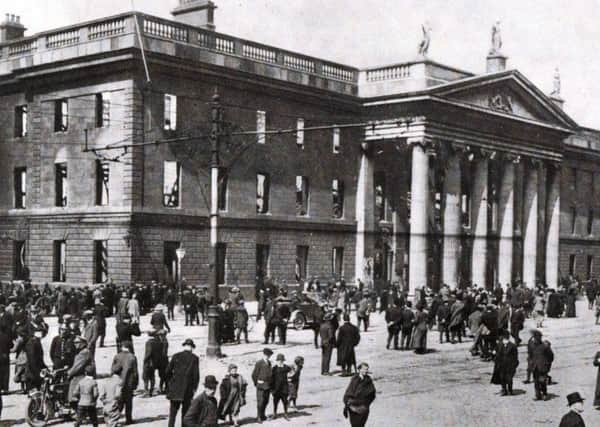

Headlined ‘Ten Days in Dublin-Derry Lady’s Experience’, the ‘Journal’ said it was a description of ‘great destruction of life and property’ and that what was to follow was a ‘interesting narrative’.
The article began: “A lady from Derry who left the city on Saturday morning April 22, to pay a visit to some friends in Dublin arrived back yesterday, and, though, fortunately she was able to report immunity from special hardships or personal injury, yet she acknowledged that she spent a period of much anxiety in the disturbed metropolis.”
Advertisement
Hide AdAdvertisement
Hide AdSpeaking to the ‘Journal’, the lady said: “I arrived in Dublin about one o’clock on Easter Saturday, and the weather being good, spent a pleasant Easter Sunday. I may say, I was residing in a hotel in the Rutland Square district. The first indication I received of anything unusual occurring was soon after one o’clock on Easter Monday. At the time I was walking with a member of the household where I was staying, a child of about ten years of age.
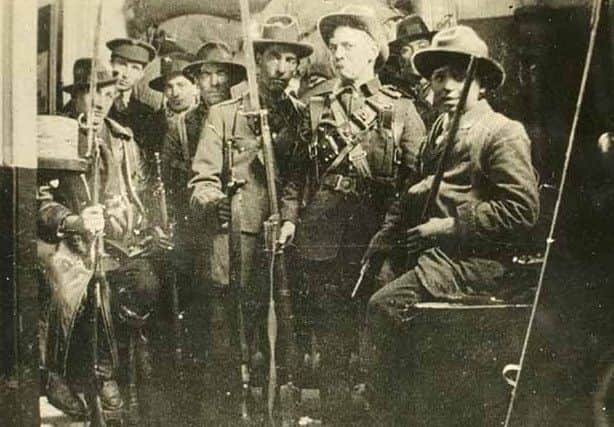

‘We were moving along slowly, admiring the shop windows and large public buildings in O’Connell Street.We had just reached Clery’s extensive drapery establishment when we heard a great noise in the direction of the General Post Office.
(On a point of clarification, whilst O’Connell Street was not officially named as such until 1924, in 1916 the official name was Sackville Street, it was referred to by most people even then as O’Connell Street because of the presence of a monument placed there in honour of nationalist leader Daniel O’Connell in 1862)
“When I looked across I saw the windows of the Post Office being broken from the inside. After each thrust of short sticks or mallets, flakes of glass fell with a crash on the footway. It was the noise of the falling glass that soon attracted a crowd in the vicinity. I remained where I was having a clear view of the Post Office windows and the damage was being done by about a half-dozen persons, three of whom were only young boys and three men beyond middle age.
Advertisement
Hide AdAdvertisement
Hide Ad“The next thing that attracted my attention was a flag being hoisted on the roof of the Post Office, one fold of which was green in colour, but the breeze was so slight that the ensign was not fully extended. There were no shots fired at this time in this neighbourhood, but I heard the breaking of glass in a similar way in a hotel not very far away.
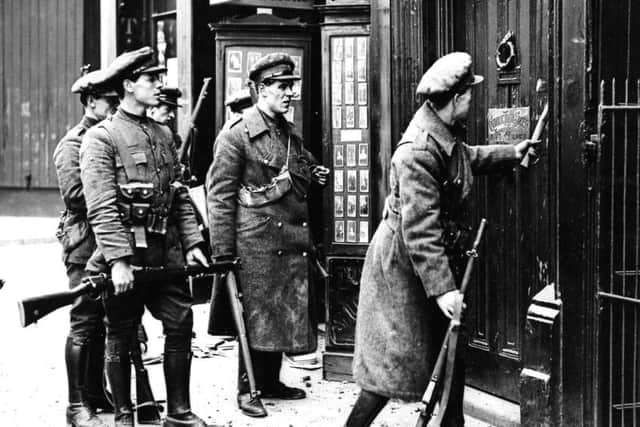

“I had not the slightest idea beyond thinking it was a freak of marauders, probably under the influence of drink. Myself and the child who was with me remained at the point where we first halted for a space of about 15 minutes. I saw no policemen or soldiers, but I noticed that the crowd attracted by the glass breaking rapidly increase its dimensions by people running from the side streets to see what was the matter. Considering the affair was simply an irregular outburst that the police would deal with, we retraced our steps back to Rutland Square, walking slowly as we did not feel in any way alarmed. The intervening thoroughfare was perfectly quiet and we got home without observing an unusual incident.
“I was about ten minutes or so in the hotel when a number of cavalry men, I believed they belonged to a Lancer Regiment, passed along. The horses were walking and the soldiers seemed quite unconcerned. I heard since that these men had been out for a horse exercise parade and when I saw them apparently they had no news of the exciting events which had begun to be enacted. Just after the cavalry passed I heard, for the first time a few shots, and that at that time, presuming they didn’t turn into O’Connell Street, they would be about opposite the Post Office. A short time afterwards, a hotel visitor came in and stated that two soldiers and their horses had been shot.
“Subsequently, that evening about 5.30, I went as far up as O’Connell Bridge. During this walk that aspect of the thoroughfare between the Pillar and the O’Connell monument had completely changed. Instead of the broad roadway being completely empty, as I had noticed it was at one o’clock, it was now considerably crowded with a throng of people, old and young men, women and children who appeared to have been brought thither mainly by curiosity. The bulk of them had gathered around the carcasses of the two horses, which I saw lying in the middle of the street near the Pillar. I saw no sign of wounded men there, nor did I observe any signs of indications of police or soldiers in the throng.
Advertisement
Hide AdAdvertisement
Hide AdThe ‘Journal’ reporter then asked the woman if she looked at the General Post Office at this point’.
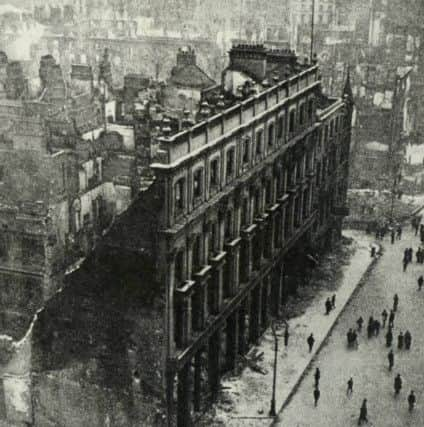

She replied: “I did and I noticed that the windows had been barricaded up with bags apparently filled with clay or sand. But, beyond this, there was nothing exceptional to be observed about the appearance of the building. Moving along the bridge, I halted beside Hopkins’ the jewellers. At that time neither Clery’s, Noblett’s or any other establishment within range of my vision was damaged. The windows were not interfered with, and the display of goods was to be seen as usual. One strange thing, however, I did notice was this-A line of barbed wire was tightly drawn from the Post Office Pillars across the other side of the street. It was about three feet from the road surface and people coming along had to stoop beneath it to get past. There was no other observation there at that time.
“Having reached Hopkins’, I decided to walk back to Rutland Square and when returning I noticed eight of nine young men in civilian garb standing on the verandah of one of the banks. Each man had a rifle in his hand. I also remarked that some of the furniture had been removed, apparently from this building, and placed upon one of the side streets as a barricade of about four feet high. Otherwise I went back and I saw nothing unusual. There was neither shouting nor the sound of shooting, nor any evidence of excitement prevalent.
“People were asking one another what the whole thing meant, and no information was available to solve the puzzle. I had got opposite the Rotunda when I saw a body of a couple of hundred of soldiers quickly marching towards Nelson’s monument. They carried their rifles. Looking back I saw that when the military had reached the Pillar shots were fired. Several volleys were fired and I saw the people who stood in the street running helter skelter in all directions. The soldiers halted at once and seemingly opened a heavy fire in the direction of the Post Office. I hurried back to the hotel. many people ran past me in the same direction.”
Advertisement
Hide AdAdvertisement
Hide AdFrom this point on the fighting during the Rising began to getting increasingly heavy. The Derry witness recalled that on Monday night the sound of gunfire became increasingly heavy and that “startling stories commenced to be circulated.”
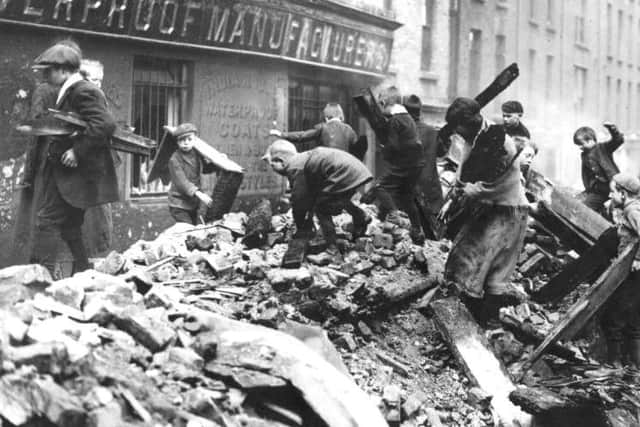

Despite this, it apparently did not deter our intrepid witness from venturing out again on Tuesday. Her travels from one o’clock, saw her traverse Westmoreland Street and to College Green where she noted that Trinity College had been taken over by the British. On reaching Stephen’s Green she and her companion heard shots and immediately turned back.
“The noise was much greater on Tuesday night than before and we were told it was principally attributable to the machine-guns used by the military that had arrived in Dublin that day. Looking out of the windows, we saw young street Arabs and hatless women and old men hurrying past with parcels in their arms. On making enquiries we heard that these were looters.
“On Wednesday I noticed that a military cordon had been drawn across the street beside the hotel and no one was allowed to pass through it except with the official authority which satisfied the sentries who stood near each other with rifles and bayonets fixed. Shooting continued throughout the day principally from machine guns. In the afternoon I was greatly startled by witnessing one of the many frightful occurrences which were happening throughout the city. A little child of about eleven years old who was passing the hotel was hit by a bullet and killed,” she said.
Advertisement
Hide AdAdvertisement
Hide AdThe effects of the battles across Dublin were now taking a human toll in more ways than the loss of life. Food supplies were running short, but our witness said that the hotel guests were replenished by ‘a plentiful supply of biscuits’. It was also on Wednesday that martial law was imposed on Dublin City with a curfew between the hour of 7.30pm to 5am. At this stage many of the prominent buildings on O’Connell street were on the verge of destruction through fire.
Thursday, said the Derry native, brought ‘terrific explosions’ caused by the bombardment of the Post Office by artillery.
“Further evidence of the dreadful occurrences on the previous days was forthcoming on Saturday when I saw ambulances conveying the dead and dying to mortuaries and hospitals. In this connection ordinary hand-carts and even bread vans were requisitioned. Firing was not so pronounced that day,’ she said.


The Volunteers surrender to the British took place on Saturday afternoon.
Advertisement
Hide AdAdvertisement
Hide AdThe witness continued: “On Sunday, everything was quiet and church services were held as usual, and on Monday, except for a few shots occasionally, they appeared to be a lull. When it was learned that the insurrectionists had surrendered the inhabitants were allowed to venture out, and visitors made arrangements to return home, but there were wild rumours in Dublin as to the conditions in Belfast and Derry and other centres.
“It was stated that in Derry a bloody conflict was proceeding and I was advised to remain in the metropolis. Later, accessing that reports were unfounded I determined to reach home and made my way to Amien’s street station which I reached about 11am. I was obliged to remain until 3pm and passengers had to take their seats on board an hour before the train started.”
The Derry witness recalled that it took 26 hours to reach her native city and that her journey was broken up by an overnight stay in Portadown.